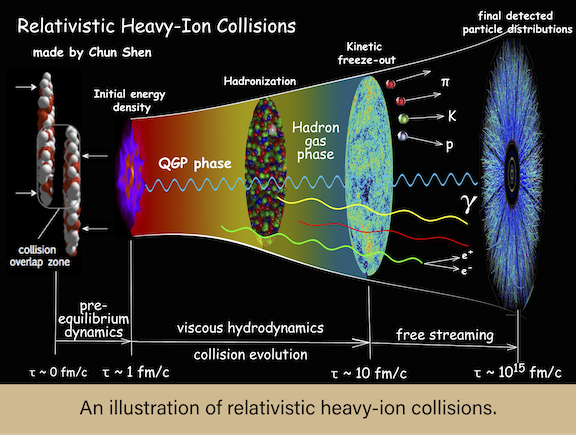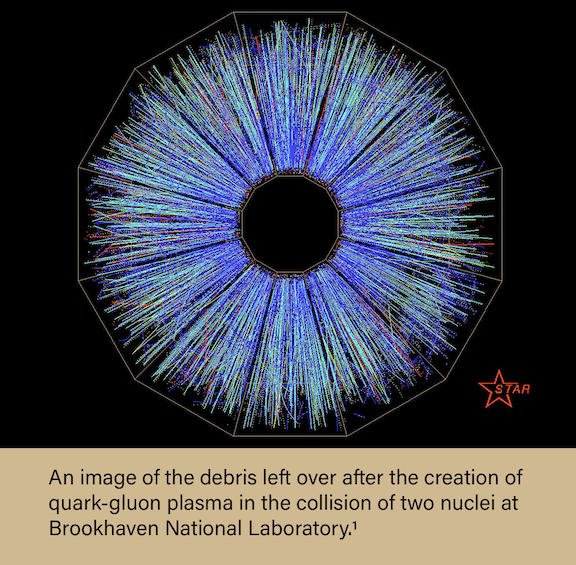Purdue’s Anvil supercomputer helps researchers look at the origins of the universe
A long time ago, before there were galaxies far, far away, there was an explosion of unimaginable proportions. Everything that ever has and ever will exist in the universe was compressed within a single point, and for reasons unknown, that point exploded—an event called the Big Bang—creating matter and propelling it outward to form the universe as we know it. For a brief moment in time, a unique state of matter known as quark-gluon plasma was created from this explosion. Within fractions of a second, this plasma was gone, forming into the protons and neutrons that make up people, plants, animals, stars, and galaxies. Now, billions of years after this quark-gluon plasma dissipated, researchers are using the Anvil supercomputer to study the plasma in the hopes of learning more about the early universe.
Dr. Chun Shen is a theoretical physicist and assistant professor in the Department of Physics and Astronomy at Wayne State University. He, together with the JETSCAPE team, has been using Anvil to run Monte Carlo simulations of “Big Bang-esque” events in order to gain more insight into quark-gluon plasma. Using data gathered from heavy-ion collision experiments completed inside particle accelerators, the JETSCAPE team can reverse engineer the event and simulate a moment-to-moment breakdown of what occurred, giving unique insight into a process that happens too quickly to be observed and measured in real-time.
“We are trying to understand the property of nuclear matter  under extremely hot and extremely dense conditions,” says Shen. “These conditions occurred a few microseconds after the Big Bang, and can be recreated in a particle accelerator by colliding heavy nuclei at near speed of light. What we have found on the experimental side is that there is a new phase of matter called quark-gluon plasma created in this type of collision, but the lifetime of this is really short—it’s in terms of 10 to the minus 23 or 24 seconds. It’s very, very, very short-lived. So we have to rely on model simulations in combination with the experimental measurements to tell us what actually happened during this short amount of time.”
under extremely hot and extremely dense conditions,” says Shen. “These conditions occurred a few microseconds after the Big Bang, and can be recreated in a particle accelerator by colliding heavy nuclei at near speed of light. What we have found on the experimental side is that there is a new phase of matter called quark-gluon plasma created in this type of collision, but the lifetime of this is really short—it’s in terms of 10 to the minus 23 or 24 seconds. It’s very, very, very short-lived. So we have to rely on model simulations in combination with the experimental measurements to tell us what actually happened during this short amount of time.”
To better understand quark-gluon plasma, we must first discuss quarks and gluons. Quarks and gluons are elementary, subatomic particles that form the building blocks of protons and neutrons, which in turn are the building blocks of atomic nuclei. These particles are on an extraordinarily small scale. For reference, imagine you have a magic microscope with the ability to zoom infinitely on any object, and you use that microscope to examine a human being. At first, you see the entire person. Zooming in slightly, you will see that a human is made up of organs, such as your brain and heart. Zooming in a little more shows that these organs are made up of different types of tissue, and each tissue is made up of even smaller parts known as cells. If you zoom in on an individual cell, you will see that it is made up of organelles—the nucleus, mitochondria, etc. These organelles are constituted of molecules, such as proteins and fats. Zooming in further shows that molecules are constructed out of different elements like carbon and oxygen, which can be further broken down into atoms. These atoms are formed by protons and neutrons, which are finally made up of quarks and gluons. The current scientific understanding is that quarks and gluons are the smallest particles in the universe—they cannot be broken down further. At the base level, all visible matter is made up of quarks and gluons.
Now, quarks and gluons are bonded together by something  called the “strong nuclear force” and are almost impossible to separate. The strong nuclear force is actually the most powerful force involved with holding matter together—much stronger than gravity, electromagnetism, and weak nuclear forces, which are the other three fundamental forces. But, when conditions match those seen after heavy ion collisions or the Big Bang, the quarks and gluons do separate and form a new state of matter, the quark-gluon plasma. This plasma is created because the temperature and density are so high that it “melts” protons and neutrons, allowing quarks and gluons to float freely in a nearly frictionless liquid. In fact, quark-gluon plasma is the hottest and densest matter ever produced in a laboratory. But this phase of matter is short-lived. As noted by Dr. Shen, quark-gluon plasma lasts about 10-23 seconds after a collision before it rapidly expands and cools, combining into ordinary matter that speeds away in multiple directions.
called the “strong nuclear force” and are almost impossible to separate. The strong nuclear force is actually the most powerful force involved with holding matter together—much stronger than gravity, electromagnetism, and weak nuclear forces, which are the other three fundamental forces. But, when conditions match those seen after heavy ion collisions or the Big Bang, the quarks and gluons do separate and form a new state of matter, the quark-gluon plasma. This plasma is created because the temperature and density are so high that it “melts” protons and neutrons, allowing quarks and gluons to float freely in a nearly frictionless liquid. In fact, quark-gluon plasma is the hottest and densest matter ever produced in a laboratory. But this phase of matter is short-lived. As noted by Dr. Shen, quark-gluon plasma lasts about 10-23 seconds after a collision before it rapidly expands and cools, combining into ordinary matter that speeds away in multiple directions.
Studying quark-gluon plasma can help scientists understand much about the early universe and give insight into the fundamental properties of how matter is formed. It is not clear how protons and neutrons are formed from quarks and gluons, and the only way to find out is to study the transition process of free quarks and gluons to confined ones (inside protons and neutrons). And since the plasma dissipates so quickly, simulations like the ones created by Shen and his team are the key to studying this transition.
“We simulate what happens from the beginning of the collisions to the end,” says Shen. “The experiments can only measure the end result. We match to the experiments and use the model to back trace to the early stages and understand what happened.”
These simulations, however, require a massive amount of computing power, which is why Shen’s research team needed a high-performance computing resource like Anvil.
“The large amount of simulations that we run on Anvil,” says Shen, “are to train efficient model emulators, because the models we developed are sophisticated, and they run very slowly. They are very inefficient in exploring a high-dimensional parameter space. We have about 20 model parameters related to the characterizing properties of the matter, and if I want to constrain these 20 parameters simultaneously with experimental data, it’s a 20-dimensional parameter space, which is very big. And if you have a very slow model, it’s hard to explore such a big space. So we train the model emulator using Gaussian processes, and then the emulator can run very fast.”
The JETSCAPE team is currently in the process of training the model emulator. The goal of the simulations they are running now is to generate enough high-quality training data sets which can be used to train the model. Then they can move on to Bayesian analysis to constrain the model properties. This part of the research process is the most time-consuming and would be almost impossible without an HPC resource like Anvil. But, training the model is essential for obtaining the most accurate and probable prediction of what occurred during the microseconds that quark-gluon plasma existed and how that led to the universe as we know it today.
One way in which the Anvil supercomputing cluster excels is in the lack of constraints Shen has to face when running jobs on the system. Shen noted that on other HPC clusters, “simulations had bigger constraints, but Anvil is able to handle all the things that we push through the machine, and there’s no complaint from the administrators.” Shen also stated that he can run more jobs in parallel (at the same time) on Anvil, and that the wait time in the queue is very short. All this allows the team to complete their research faster, which is a benefit for any research project.
As of now, Shen and the rest of the JETSCAPE team are focused on finishing the training of the data sets. Once this is done, Shen stated that they will be able to complete the “actual science and publication very quickly.” Hopefully, these simulations will lead to a deeper understanding of quark-gluon plasma, the properties of the early universe, and fundamental principles that guided the formation of all visible matter.
To learn more about Dr. Shen and his research, please visit his website: https://chunshen1987.github.io/
For more information regarding HPC and how it can help you, please visit our “Why HPC?” page.
The JETSCAPE Collaboration is funded under NSF award No. OAC-2004571.
Anvil is Purdue University’s most powerful supercomputer, providing researchers from diverse backgrounds with advanced computing capabilities. Built through a $10 million system acquisition grant from the National Science Foundation (NSF), Anvil supports scientific discovery by providing resources through the NSF’s Advanced Cyberinfrastructure Coordination Ecosystem: Services & Support (ACCESS), a program that serves tens of thousands of researchers across the United States. Researchers may request access to Anvil via the ACCESS allocations process. More information about Anvil is available on Purdue’s Anvil website. Anyone with questions should contact anvil@purdue.edu. Anvil is funded under NSF award No. 2005632.
- Image courtesy of Brookhaven National Laboratory. https://www.bnl.gov/rhic/images.php
Written by: Jonathan Poole, poole43@purdue.edu
